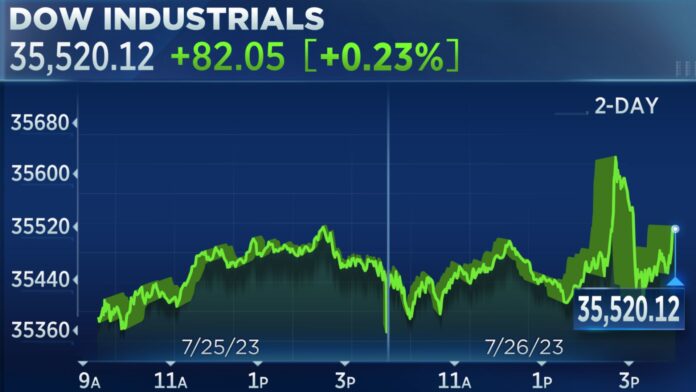In today’s fast-paced financial world, keeping an eye on the Dow Jones Industrial Average (DJIA) is essential for investors and traders alike. The Dow Jones today serves as a barometer of the overall health of the stock market, reflecting the performance of thirty major companies listed on the New York Stock Exchange (NYSE) and the NASDAQ. Let’s delve into what the Dow Jones is today and how it impacts investment decisions.
What is the Dow Jones?
The Dow Jones, often referred to simply as “the Dow,” is one of the oldest and most widely followed stock market indices globally. It was created by journalist Charles Dow in 1896 and is named after him and his business partner, Edward Jones. The Dow Jones Industrial Average tracks the stock prices of thirty large, publicly-owned companies in various industries.
Significance of Dow Jones Today
The Dow Jones serves as a benchmark for investors, providing insight into the overall performance of the stock market. Changes in the Dow Jones index can signal shifts in investor sentiment, economic trends, and corporate performance.
Understanding the Dow Jones Index
History and Background
The Dow Jones index has a rich history, originating from Charles Dow’s creation of the Dow Jones Transportation Average in 1884. The DJIA was later introduced in 1896 with twelve industrial companies, reflecting the growth of the American economy during the Industrial Revolution.
Components of the Dow Jones Industrial Average
The Dow Jones index consists of thirty large-cap companies spanning various sectors such as technology, healthcare, finance, and retail. These companies are leaders in their respective industries and are considered blue-chip stocks.
Calculation Method
The DJIA is a price-weighted index, meaning that the stocks with higher prices have more influence on the index’s movements. To calculate the index, the sum of the stock prices of all thirty companies is divided by a divisor that adjusts for stock splits, dividends, and other corporate actions.
Factors Influencing the Dow Jones Today
Economic Indicators
Economic indicators such as GDP growth, unemployment rates, and inflation play a significant role in influencing the Dow Jones index. Positive economic data often leads to higher stock prices, while negative indicators can trigger market downturns.
Global Events and Market Sentiment
Global events, geopolitical tensions, and market sentiment also impact the Dow Jones index. Political instability, trade disputes, and natural disasters can create volatility in the stock market, causing fluctuations in the Dow Jones.
Corporate Earnings Reports
Earnings reports from individual companies within the Dow Jones index can move the market significantly. Strong earnings growth and positive guidance typically result in higher stock prices, while disappointing results can lead to sell-offs.
Analyzing the Performance of the Dow Jones Today
Market Trends and Patterns
Analyzing market trends and patterns can provide valuable insights into the future direction of the Dow Jones index. Technical analysis tools such as moving averages, support and resistance levels, and chart patterns help traders identify potential entry and exit points.
Volatility and Risk Factors
Volatility is a common feature of the stock market, and the Dow Jones is no exception. Factors such as interest rate changes, geopolitical events, and regulatory developments can contribute to market volatility and increase investment risk.
Impact on Investors and Traders
The performance of the Dow Jones index directly affects investors and traders, influencing their investment decisions and trading strategies. Understanding market dynamics and staying informed about current events is crucial for navigating the complexities of the stock market.
Recent Trends in the Dow Jones Today
Current Market Conditions
In recent months, the Dow Jones index has experienced volatility amid uncertainty surrounding the global economy, inflation concerns, and geopolitical tensions. However, positive economic data and strong corporate earnings have helped support stock prices.
Notable Movements and Changes
Several factors have contributed to the recent movements in the Dow Jones index, including shifts in investor sentiment, earnings reports from key companies, and developments in monetary policy.
Expert Opinions and Forecasts
Financial analysts and market experts provide valuable insights into the future direction of the Dow Jones index, offering forecasts based on economic indicators, corporate earnings, and geopolitical developments.
Strategies for Responding to Dow Jones Today
Investment Strategies
Investors can adopt various investment strategies to capitalize on opportunities in the stock market, including long-term investing, value investing, and growth investing. Diversification and asset allocation are essential components of a sound investment strategy.
Risk Management Techniques
Managing risk is crucial for preserving capital and achieving long-term investment success. Techniques such as setting stop-loss orders, hedging strategies, and portfolio rebalancing help mitigate downside risk in volatile market conditions.
Long-term vs. Short-term Perspectives
Investors and traders may have different time horizons and objectives when it comes to trading the Dow Jones index. While some investors focus on long-term wealth accumulation, others may engage in short-term trading strategies to capitalize on short-term price movements.
Conclusion
In conclusion, the Dow Jones index plays a vital role in the global financial markets, serving as a key indicator of stock market performance. Understanding the factors influencing Dow Jones today is essential for investors and traders to make informed decisions and navigate the complexities of the stock market.




